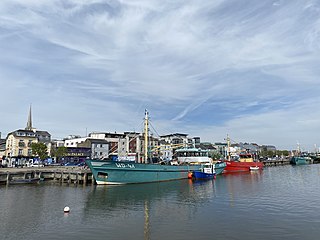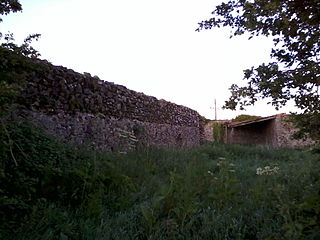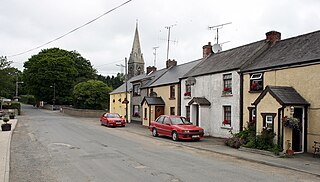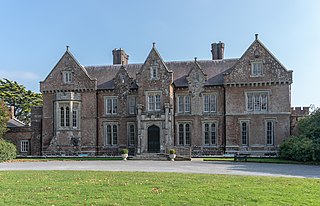Related Research Articles

Augustus Welby Northmore Pugin was an English architect, designer, artist and critic who is principally remembered for his pioneering role in the Gothic Revival style of architecture. His work culminated in designing the interior of the Palace of Westminster in Westminster, London, England, and its iconic clock tower, later renamed the Elizabeth Tower, which houses the bell known as Big Ben. Pugin designed many churches in England, and some in Ireland and Australia. He was the son of Auguste Pugin, and the father of Edward Welby Pugin and Peter Paul Pugin, who continued his architectural firm as Pugin & Pugin. He also created Alton Castle in Alton, Staffordshire.

County Wexford is a county in Ireland. It is in the province of Leinster and is part of the South-East Region. Named after the town of Wexford, it was based on the historic Gaelic territory of Hy Kinsella, whose capital was Ferns. Wexford County Council is the local authority for the county. The population of the county was 149,722 at the 2016 census.

Wexford is the county town of County Wexford, Ireland. Wexford lies on the south side of Wexford Harbour, the estuary of the River Slaney near the southeastern corner of the island of Ireland. The town is linked to Dublin by the M11/N11 National Primary Route; and to Rosslare Europort, Cork and Waterford by the N25. The national rail network connects it to Dublin and Rosslare Europort. It had a population of 20,188 according to the 2016 census.

Baron Carew is a title that has been created three times. The first creation was in the Peerage of England in 1605. The first recipient, Sir George Carew (1555–1629), was later made Earl of Totnes in 1626. Both titles became extinct on his death as he left no heirs.

Gorey is a market town in north County Wexford, Ireland. It is beside the main M11 Dublin to Wexford road. The town is also connected to the railway network along the same route. Local newspapers include the Gorey Guardian.

Enniscorthy is the second-largest town in County Wexford, Ireland. At the 2016 census, the population of the town and environs was 11,381. The town is located on the picturesque River Slaney and in close proximity to the Blackstairs Mountains and Ireland's longest beach, Curracloe. The town is twinned with Gimont, France. The Placenames Database of Ireland sheds no light on the origins of the town's name. It may refer either to the "Island of Corthaidh" or the "Island of Rocks". The cathedral of the Roman Catholic Diocese of Ferns is located in the town as well as an array of other historical sites such as Enniscorthy Castle and the key battle site of the 1798 Rebellion.

Kilmore Quay is a fishing village near Kilmore, in County Wexford, Ireland. As of 2016, it has a population of 372. It is a fishing village, but its leisure facilities such as sailing, and sea angling charters are also of economic importance.

Geneva Barracks in County Waterford, Ireland, was a barracks created in 1783 by converting a settlement which had been created for an 18th-century colony of disaffected citizens of Geneva following the Geneva Revolution of 1782. Built near Passage East, the colony was commissioned by the Irish Parliament and approved by British Royalty. After the Genevans abandoned their plans to settle in Waterford, the colony became a British military barracks which gained notoriety as a deadly holding centre for rebel prisoners during and after the 1798 rebellion. Today, the only remains of New Geneva are its ruined walls in a grassy field.

Denis Brennan is an Irish Catholic bishop. He was Bishop of Ferns from 2006 until his retirement in 2021.
Daniel Robertson was a British architect.

Kilanerin or Killinierin is a village in north County Wexford, Ireland, 4 kilometres west of the N11 road, near the village of Inch and approximately 12 kilometres from the town of Gorey.

Murrintown, also spelled Murntown, is a small village located in the southeast of County Wexford, in Ireland, close to Wexford town. It is part of the parish of Piercestown.
William Day was an Irish architect and builder active in the southeast of Ireland in the late eighteenth and early nineteenth century. He was related to architects John Day and Martin Day, both of County Wexford. His only known design was for the replacement St. Mary's Church of Ireland Church, Kilmore, County Wexford (1798–1802), although he was not responsible for the tower (1889), annexe (1898), and later vestry (1935).
Richard Purcell was an Irish architect and builder active in mid-nineteenth-century County Wexford, in the southeast of Ireland. He was associated with the Day family of architects, which included Martin Day, William Day, John Day.

Ibar mac Lugna, whose name is also given as Iberius or Ivor, was an early Irish saint, patron of Beggerin Island, and bishop. The saint is sometimes said to have been one of the "Quattuor sanctissimi Episcopi" said to have preceded Saint Patrick in Ireland, although possibly they were just contemporaries. His feast day is 23 April.
Thomas Alfred Cobden was an English architect, best known for designing many buildings in south-east Ireland, such as Cathedral of the Assumption, Carlow, Duckett's Grove and Browne-Clayton Monument.

Wells House and Gardens is a Victorian tudor gothic country house museum, located around 7 km outside of Kilmuckridge, County Wexford. It was designed by Daniel Robertson in the 1830s. It replaced the original house which was built in the late seventeenth century by the former Cromwellian army officer John Warren, and bought after his death by the eminent judge Sir Robert Doyne: the Doyne family lived here until 1964.

William Robertson, an Irish architect, was born in Kilkenny, Ireland, some days before 4 December 1770. He attended the Dublin Society where he was awarded with a silver medal for his drawing skills in 1795.
Ballyhogue or Ballyhoge is a village and census town in County Wexford, Ireland. The village, which lies in a townland and civil parish of the same name, had a population of 269 people as of the 2016 census.
References
- 1 2 See Frederick O'Dwyer, "'Modelled Muscularity:' Daniel Robertson's Tudor mansions," Irish Arts Review Yearbook 15 (1999), 91. Cited in Irish Architectural Archive, Dictionary of Irish Architects 1720-1940.DAY, MARTIN (Accessed 12 Oct 2010)
- ↑ See also David Rowe & Eithne Scallan, Houses of Wexford (Ballinakella Press, 2004), no.484